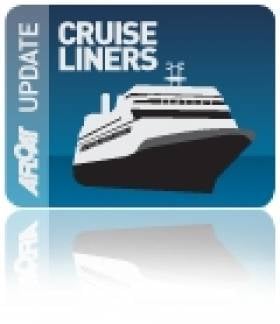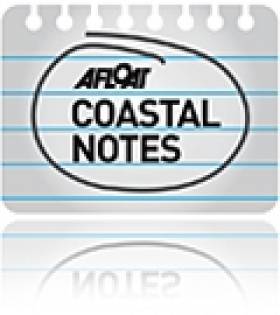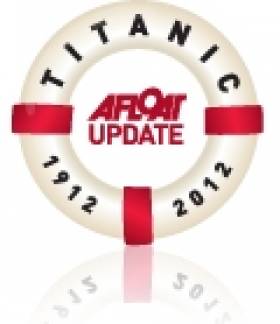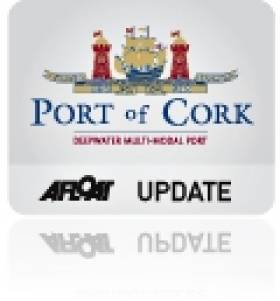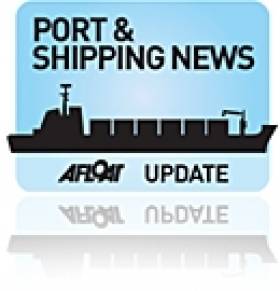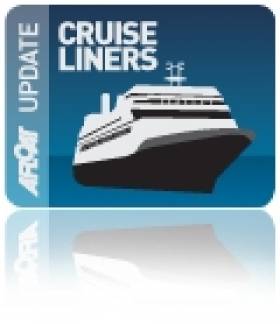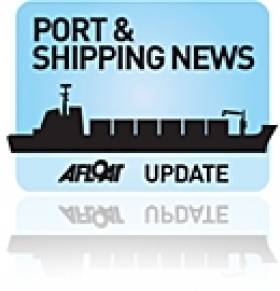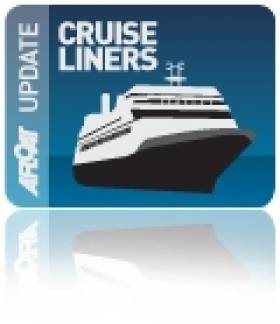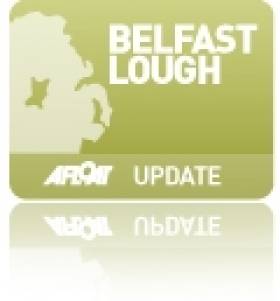Displaying items by tag: Cruise Liners
#CruiseShips- A mini-luxury cruiseship Sea Explorer docked in Dun Laoghaire Harbour today, fortunately without passengers on board, as a very unseasonable Dublin Bay was battered by a heavy snow squall, writes Jehan Ashmore.
As the Sea Explorer approached Dun Laoghaire Harbour, the pilot cutter 'Liffey' which set out from Dublin Port came alongside to transfer a pilot aboard the 4,200 tonne vessel which was arriving on a passage from Cadiz.
Sea Explorer which has a passenger capacity for 116 passengers is to remain moored in the harbour albeit in a 'lay-up' mode in advance to taking up a European season with cruises starting in June from a temporary 'homeport'.
It is the norm for cruiseships to reposition between seasons and operating regions around the world, such as the Caribbean and Mediterranean and relocate to a designated homeport.
As previously reported on Afloat.ie, Dun Laoghaire Harbour is expected to receive up to 14 cruise calls this season, including the highlight call of Cunard Line's flagship liner 'QM2' on 16 May.
Also reported was yesterday's launch of the National Ports Policy where Minister for Transport, Leo Varadkar announced that Dun Laoghaire Harbour along with four other ports were classed as having 'regional significance'.
In the case of Dun Laoghaire Harbour, the development of the port is to be in line with local requirements focusing on tourism, cruise liners and marine leisure activity.
The ports are to be transferred to the control of local authorities in a move that will require legislation which may take up to 18 months to complete.
Meanwhile, Sea Explorer will be sharing the same quayside at the ferry terminal with the new Dublin Bay Cruises excursion vessel, St. Bridget.
On the adjacent berth is another vessel with a similar name to the cruiseship, that being the HSS Stena Explorer which operates the seasonal-only fast-craft ferry service to Holyhead.
Finally, the port has also been engaged in a return to cargsoships with the third batch of Guinness fermentation tanks, which were discharged from the Blue Tune on Monday. This final batch are bound for the St. James's Gate Brewery plant in Dublin.
#DublinBayCruises – In addition to news of a boost in Dun Laoghaire Harbour in attracting up to 14 cruise callers this season, a new excursion operator Dublin Bay Cruises are to run trips to and from Howth Harbour, writes Jehan Ashmore.
To book your trip call 353 1 9011757 and tell them you read about it right here, on Afloat.ie !
Dublin Bay Cruises are to begin excursion trips in early April. The 90 minute trips will take in the expanse and scenic vista of Dublin Bay, passing coastal landmarks along with views of Dalkey Island in the south of the bay, Howth Peninsula to the north and Ireland's Eye off Howth Harbour.
During the cruise, passengers will have an audio guide to explain and understand how and why the modern city of Dublin developed to become the capital city of Ireland.
The itinerary departing Dun Laoghaire Harbour will be as follows: the Joyce Martello Tower – Dalkey Island – north cross the bay towards Howth head – Bailey Lighthouse-Irelands Eye-Howth Harbour.
On trips departing Howth Harbour the itinerary is in reverse: Irelands Eye- Bailey Lighthouse-south cross the bay towards Dalkey Island-Joyce Martello Tower and arriving to Dun Laogaire Harbour.
The cruise is offered as a one-way trip (in either direction) between the harbours. Passengers will be able to make their way back to the city-centre from either Dun Laoghaire or Howth harbours by taking the DART train or use of other public transport links.
Both DART stations in Dun Laoghaire and Howth are less than 300m from the berthing locations.
Dublin Bay Cruises are to operate the excursion vessel 'St. Bridget', a 26m steel-hulled vessel with a capacity for around 100 passengers. There will be a bar facility also serving light refreshments.
Interestingly, bicycles will also be carried, providing another travel mode to continue at either destinations and bringing further flexibility.
The cruise trips will also bring a whole new dynamic to crossing Dublin Bay, linking two large sailing centres and in the case of Howth Harbour which has a large fishing fleet and seafood restaurents.
St. Bridget will be the first commercial vessel to use Dun Laoghaire Harbour's new cruise-tender pontoon which was installed nearly a year ago, last April.
She is one of five passenger ships owned and operated by Dublin Bay Cruises, a sister company of Doolin2Aran Ferries which operates from the Co. Clare harbour. Earlier this month, the go ahead was granted for the construction of a new pier.
The cruise-tender pontoon located in Dun Laoghaire's 'Coal' Harbour was installed primarily to cater for the return of cruise ships sector.
The most impressive cruise caller will be the giant Cunard liner Queen Mary 2 of 151,400 tonnes, which is to make her debut call to Dublin Bay in mid-May with an 'anchorage' call. She has a capacity for 2,620 passengers and more than 1,200 crew.
In total Dun Laoghaire Harbour is to welcome up to 30,000 passengers and crew ashore in 2013.
The increase in the level of cruise calls is notable, considering last year's first season after a gap of several years, generated just two cruise calls. Both in which were carried out by the same vessel, the diminutive cruiseship Quest of 1,180 tonnes which has a capacity of only 50 passengers.
'Titanic II' Plans Unveiled By Mining Millionaire
#Titanic - An Australian mining millionaire has unveiled his plans to resurrect the Titanic for the 21st century, as The Irish Times reports.
Clive Palmer wants to build a new version of the ill-fated cruise liner - to be dubbed Titanic II - recreating the style and comfort of the original, but with modern navigational instruments and enough lifeboats for all on board.
"Titanic was a ship of dreams and Titanic II promises to be the ship where dreams come true," he told reporters at the Ritz Hotel in London last week.
Already he claims that 40,000 people have enquired about passage, and 16 individuals have offered $1 million each for a state room on the new liner for its maiden voyage after the vessel is completed in late 2016.
Titanic II will not be an exact replica of its predecessor, as it's planned to be four metres wider to provide greater stability, as well as featuring stabilisers and reverse propellers to provide for a more comfortable voyage.
It will also not be built at Harland & Wolff, the Belfast Lough shipyards that constructed the original White Star Line vessel, instead being contracted to the world record-holding large ship facilities at Jiangsu in China.
The Irish Times has more on the story HERE.
Public Consultation On Future Of Bantry Bay Harbour
#IrishHarbours - The Department of Transport, Tourism and Sport (DTTAS) is asking members of the public and all interested parties for their views on plans to merge Bantry Bay Harbour with the Port of Cork Company.
The department believes that the future of Bantry Harbour would best be secured through a merger, and is seeking views on the proposals by 5 April.
Government policy is to merge harbours with significant commercial traffic with a port company, and to transfer smaller harbours to a local authority. To date 11 harbours have transferred to local authority control. Bantry Bay Harbour is now the only regional harbour operating under the Harbours Act of 1946.
A Review of Regional Ports and Harbours in 1999 recommended that Bantry Bay Harbour Authority should merge with the Port of Cork company, on the grounds of good governance.
The core business of Bantry Bay Harbour is the oil storage and transhipment terminal on Whiddy Island. Aquaculture, fishing and tourism are also prevalent in the harbour and a small number of cruise liners visit the harbour each year.
Amalgamation with the Port of Cork would provide access to port expertise, marketing, strategic development planning and the skills required for the regulation of navigation, ship and port security requirements, pilotage, safety, emergency response, and pollution.
The Port of Cork currently provides this professional expertise through the provision of harbourmaster services, on a contractual basis, to bring in large oil tankers and cruise liners into the bay. This is an absolute requirement to operate business in Whiddy to help mitigate the risks of maritime accidents and environmental damage.
Should the transfer take place to the Port of Cork, there is an opportunity for the port to provide local representation to Bantry Bay and some investment back into the harbour. The opportunity also exists for the Port of Cork and the local authority to co-operate with regard to the future development of the harbour.
Missing 'Ghost Ship' May Have Sunk In Atlantic
#GhostShip - The Irish Coast Guard is on alert after indications that the missing 'ghost ship' MV Lyubov Orlova may have sunk in the Atlantic as it drifted towards Ireland's coast.
RTÉ News reports that an emergency transponder signal on the vessel that only activates on contact with water was picked up by coastguard monitors last week.
No sign of the ship was detected in satellite images of the area some 1,700km west of Valentia where the signal originated, leading to speculation that the ship has sunk.
But the possibility that the signal device was washed overboard cannot be ruled out.
As previously reported on Afloat.ie, the MV Lyubov Orlova was being transported from Canada to the Caribbean for scrapping in late January when it broke free of its tow-line and went adrift in the Atlantic in the general direction of Europe.
With no lights and its Automatic Identification System (AIS) switched off, it could not be located by conventional means - leading the Irish Coast Guard to collaborate with marine surveillance expert Guy Thomas on his new Global Maritime Awareness system in the hopes of detecting the vessel as it approached Irish waters.
The MV Lyubov Orlova is the sister ship of the polar cruiser Clipper Adventurer, the first ever cruise liner to visit Drogheda Port when it entered the mouth of the Boyne last summer.
Five Die In Canary Island Cruise Ship Lifeboat Drill
#CruiseLiners - The Guardian reports that five crew members on a British-operated cruise liner in the Canary Islands have died after a lifeboat fell 17 metres from the side of the ship and overturned during an emergency drill.
The crew - believed to include Indonesians, a Filipino and a Ghanaian - are thought to have been on board the lifeboat as it was being lowered from the vessel at the time of the incident.
Lifeboat launch drills are notorious for accidents, according to seafarers' union Nautilus International, who added that "there's been research which suggests that more people are dying in lifeboat drills than are being saved by lifeboats."
The Canary Islands are a popular holiday destination for people from Ireland and all over Europe seeking some winter sunshine. Reports say 2,000 passengers were on the cruise ship at the time but none were involved in the emergency drill.
The Guardian has much more on the story HERE.
Drogheda Port Handled 1m Tonnes in 2012
#DroghedaPort – Over 1m tonnes of cargo was handled in 2012 by the Drogheda Port Company.
According to the Co. Louth port, this level of cargo outperformed the Irish port sector in terms of year on year throughput growth.
Throughputs increased by 95% on last years volumes and it is the first time since 2007 that the port handled over one million tonnes of cargo.
The latest national volumes indicate that the volume of port and shipping traffic through the Republic of Ireland showed little growth in the third quarter of 2012 according to the figures released by the Irish Maritime Development Office (IMDO).
The latest analysis of national traffic data indicates that two of the five principal freight segments returned to growth in the third quarter, two declined and one remained unchanged.
Against this backdrop Drogheda Port's volume growth is particularly impressive. Export volumes performed well with minerals, construction bulks and agri-trades all increasing.
The company is continuing to provide a competitive operational base to its many customers and attract new business with increased flexibility and facilities.
Nationally the outlook for the sector in 2013 remains challenging as continued uncertainty in the European and wider Global Economy continues to weaken market demand and impact on consumer confidence.
Commenting on the ports performance CEO Mr Paul Fleming said "The company is pleased to report that trade volumes increased significantly in 2012 and we will continue to grow volumes in 2013 in specific market sectors. It is also noteworthy that the port is playing a central role in facilitating the national export lead recovery."
He also noted "The company continues to support the local tourist economy with the first ever cruise call (as previously reported on Afloat.ie of the Clipper Adventurer) in 2012. A number of new maritime tourism initiatives will be announced in 2013 to support and stimulate the local economy."
Ferry & Cruise Exhibitors at Holiday World Show, Dublin
#HolidayWorldDublin- The annual Holiday World Show, Dublin is underway having opening yesterday in the RDS Simmonscourt Complex, Ballsbidge. As previously reported, Eoghan Corry's Expert Travel Clinics will include talks on those considering taking a cruise.
The FREE travel clinic (see times) will have expert speakers from a broad variety of holiday options from around the world, and they will be on hand to answer consumer questions from the floor.
Among the Ferry & Cruise Exhibitors are Celtic Link Ferries, Stena Line, Shannon Ferries, Hurtigruten, Azamara Cruises, RCL, P&O Cruises, Fred Olsen Cruise Lines and MSC Cruises. For a list of Exhibitors click HERE and for further information on opening times (final day is tomorrow) and admission rates visit: www.holidayworldshow.com/visit-page51329.html
Expert Cruise Talks at Holiday World Show, Dublin
#CruiseHolidays- Starting today is the Holiday World Show, Dublin in the RDS Simmonscourt Complex, Ballsbidge and where Eoghan Corry's Expert Travel Clinics will include talks on those considering taking a cruise.
Over the three day show (25,26 and 27 January) the FREE travel clinic will have expert speakers from the cruise sector and from other holiday options from around the world. They will be on hand to answer consumer questions from the floor.
The following speakers representing the cruise sector are:
Lorraine Quinn, Irish Manager of Royal Caribbean Cruise Lines (RCL), which has more than 70% of the Irish cruise market.
Rebecca Kelly, Development Manager of MSC cruises, the Italian cruise line which has become a big favourite of the Irish holiday population.
Sonia Limbrick of Azamara cruises, one of the most luxurious cruise lines in the world which has chosen Dublin as a departure point for a selection of its cruises.
Below is a schedule of the Cruise holiday talks, noting a full listing of holiday topic talk times can be viewed HERE.
Friday 25 January
17.00pm Cruising Rebecca Kelly of MSC Cruises & Lorraine Quinn of RCL
Saturday 26 January
12.30pm Luxury Cruising Sonia Limbrick of Azamara Cruise Line
Sunday 27 January
13.45pm Cruise Opportunities in 2013 by Tom Maher
For further details on opening times and admission rates, visit: www.holidayworldshow.com/visit-page51329.html
Belfast’s Record-Breaking Cruise Boost
#BelfastCruiseCalls – The 2013 season will bring a record 57 cruiseships and more than 100,000 visitors to Belfast Harbour, compared to last year when only 44 cruiseships docked with 75,000 passengers, writes Jehan Ashmore.
Tourists from all corners of the globe are to visit Northern Ireland, having booked cruises with leading operators, among them Princess Cruises, Holland America Line, Celebrity, MSC, Thomson, Fred Olsen Cruise Line and Saga Cruises. The first caller of the season is the ultra-luxury Hebridean Princess, when she is to make a port of call in April.
Last month, Cruise Critic UK, the leading source of cruise information on the web, named Belfast as 'Best UK Port of Call' in their Editors' Picks Awards 2012.
The continuing success of Belfast as a destination to an international cruise market has been built from the efforts of Cruise Belfast, a marketing initiative between Belfast Harbour and Belfast Visitor and Convention Bureau (BVCB).
Anne McMullan from BVCB said "Cruise travel globally is one of the fastest growing and highly competitive areas of tourism and the record-breaking cruise ship numbers arriving in Belfast are a testament to the city's tourism success and how far we have come".
Asides the new Titanic Belfast Centre, which has arguably done for the city what the Guggenheim did for Bilbao, the port acts as a 'gateway' to the rest of Northern Ireland, where attractions are within a short coach trip to the Giants Causeway, Mount Stewart and St Patrick's Country.





























